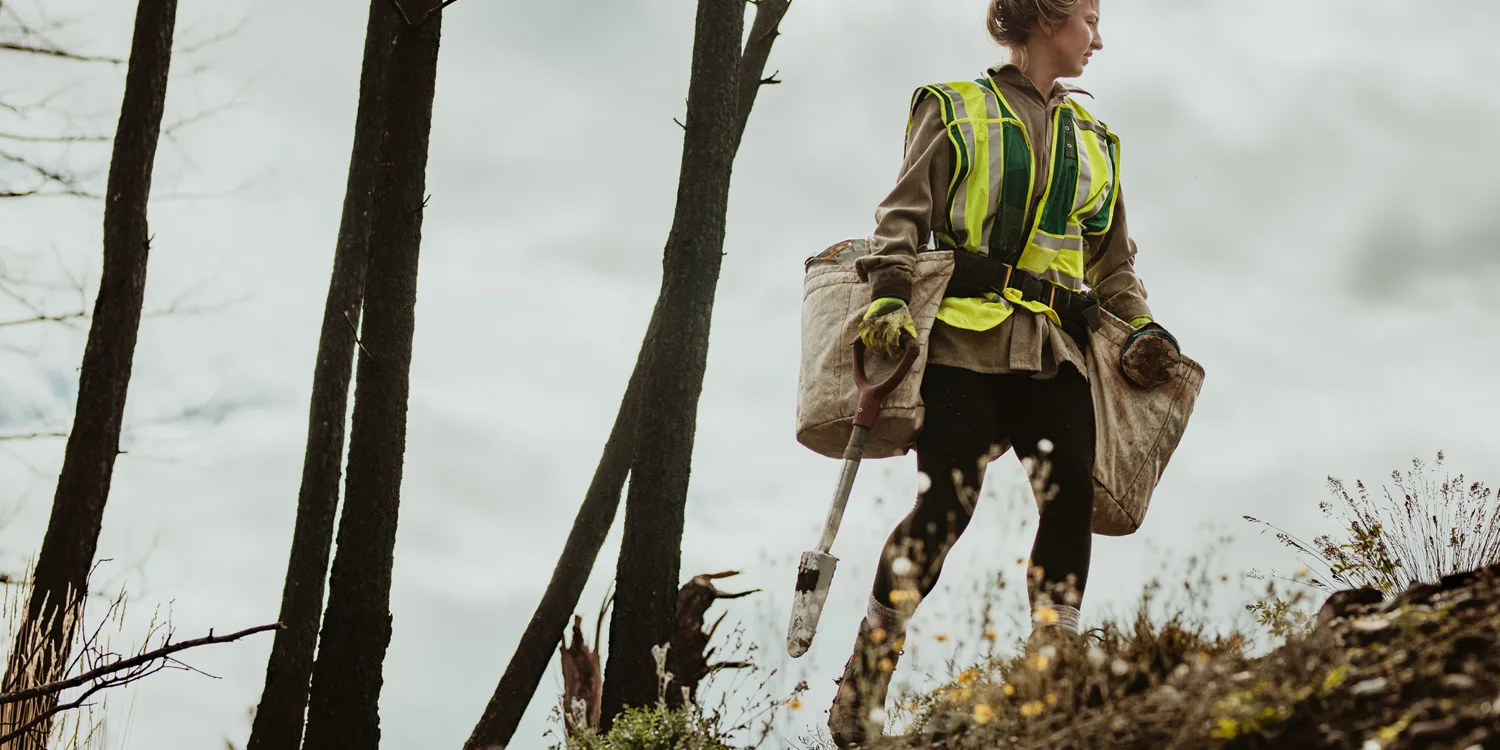A wild proposal: Tools that can help restore nature
By Jason McBride | July 23, 2025

More intense wildfires make it harder for forests to recover on their own. Scientists and entrepreneurs are exploring how we can give them a helping hand.
When deadly wildfires began to ravage Los Angeles last January, Nina Raj’s first thought was this: Save the seeds. Raj is the founder of Altadena Seed Library, a beloved community seed library and educational resource that helps residents grow food, expand green spaces and connect with neighbours. “They represent so much hope,” Raj told LAist. But she knew that once the fires were contained and L.A. began the difficult process of cleaning up, seeds would need to do even more than that — they would be the first, vital step in repairing and restoring the woodlands, gardens and wildlife habitats the fires had wiped out.
This is a tragic new dimension of wildfire. Over millennia, forests have evolved to withstand the intermittent shocks of fire or insect attacks; conifers in Canada’s immense boreal forest, in fact, depend on fire to germinate their seeds. But climate change has led to more frequent and intense fires that obliterate everything. “For the first time ever, we’re seeing boreal forests that are not recovering after forest fires,” says Faisal Moola, an associate professor and director of the People, Plants and Policy Lab at the University of Guelph. “The fires are so hot, they burn deep within the soil column and there are no peripheral trees with seeds that can blow in.”
When damaged ecosystems can’t recover on their own, human beings must restore them. The trouble is, the world is facing a global seed shortage. A report released by the United Nations Food and Agriculture Organization in March found that climate change, lack of investment and unreliable seed collection means many countries are struggling to meet the UN’s target of 3 per cent increase in global forest area by 2030.
But rethinking how we treat our natural spaces and improving the way we collect seeds can go a long way to solving this problem. Here, a look at some counterintuitive approaches to restoration.
How do we restore nature in a changing climate?
Trees can naturally adapt to hotter and drier conditions, but the rapid pace of climate change makes that far more challenging. How do you restore an ecosystem that may no longer support the species that once thrived there?
One recent conservation strategy has been assisted migration or seed transfer. “It’s exactly what it sounds like,” says Blaine Pearson, the founder of Seedark, a Toronto-based startup that’s developing digital tools to modernize the seed supply chain. “It’s essentially taking seeds or genetic material from one spot and moving it to another.” Historic climate shifts have always caused species to migrate, but with the climate changing so quickly, proactively helping species relocate to areas that will be more hospitable in the future could improve their chances of survival. Like other geo-engineering projects, assisted migration is controversial — for one thing, there’s the risk of further damaging ecosystems by introducing invasive species — but Pearson argues that new tech tools can help reduce risk. “When you layer in technologies like AI,” she says, “and the ability to take data sets, forest fire modelling or ecosystem shift models, and put those together to produce precision prescriptions, that also helps to possibly change the game.”
British Columbia, to cite one high-profile example, plants 275 million seedlings a year. Rapid climate change is expected to lead to maladaptation, disease and pest infestation in many of those trees as they mature. To mitigate those effects, government researchers began an assisted migration adaptation trial more than 16 years ago. Between 2009 and 2012, they planted seeds from 15 B.C. tree species in reforestation sites from Northern California to southern Yukon, and are monitoring their growth to best determine which species will best adapt to future climates. Given how slowly trees grow, however, researchers aren’t expecting any concrete results for at least another decade.
How do we get the seeds we need?
Anyone can get tree seeds at a nursery or online. But large-scale ecological reforestation requires careful sourcing and selection of seed stocks to ensure what’s being planted is high-quality and genetically and regionally appropriate. While many seed banks exist, there is only one in Canada that’s entirely focused on trees and shrubs: the National Tree Seed Centre in Fredericton, N.B. It’s currently gathering a representative sample of every tree or shrub species in the country. There are more than 700 species that occur naturally in each eco-district (an area characterized by distinctive landforms and vegetation), and there are more than a thousand eco-districts in Canada. “The goal is to capture a good representation of each species,” says Martina Albert, a technician at the NTSC, “so that seed can be stored for generations and potentially used in restoration efforts or after a natural disaster.”
Saving seeds for posterity is important, but we also need to make it easier to source seeds right now. “We currently don’t have universalized systems to trace where seed has come from,” says Seedark’s Pearson. The cloud-based shared ledger that her company is developing aims to bring together government, nurseries and tree planting organizations to “create a global grid of communities who are connected through technology in identifying, collecting and storing seeds relevant to their ecosystem,” she says.
Will planting trees be enough?
Trees can play an outsized role in tackling climate change. Protecting the forest we have now and restoring degraded forest and planting new forests, Moola says, “could account for as much as 30 to 40 percent of the carbon dioxide mitigation required by 2030 to ensure that global warming is capped at 2 degrees Celsius.”
But he also says we can’t, well, miss the forest for the trees. Much reforestation is being done simply in the name of offsetting carbon — monetizing tree planting, in other words — and is not actively increasing biodiversity. “We’re seeing carbon offset projects claiming to be ecological restoration but in fact they’re industrial plantations,” Moola says. “Very low biodiversity, one or two trees, planted in rows. In many cases, they’re actually in conflict with local communities and Indigenous peoples.”
Sometimes, he argues, we simply shouldn’t plant at all. There are spaces that have been lost to wildfire or other natural disturbances. But Moola believes such recently transformed areas (grasslands, wetlands, etc.) can provide different, valuable kinds of biodiversity. And that because ecosystems are changing so rapidly, we should often accept them as they are. “Everyone loves forests,” Moola says. “But our prioritization and preference for trees is many times at the expense of open natural ecosystems. They also need to be protected and restored.”
What can the average person do?
While the Altadena Seed Library itself miraculously survived the L.A. fires, Nina Raj immediately put out a call asking for seed donations that could help restore the area. But proactively gathering seeds is good practice even if you’re not cleaning up after a disaster. The Toronto Seed Library has 14 different outposts across the city, where you can donate or pick up seeds. (Some are open 24/7, others only by appointment — check the website first.)
If you grow plants, especially native ones, save your own seeds as well. You can also support organizations such as Forests Canada by participating in its Planting Delivery Agent or Take Root programs. In 2021, Forests Canada partnered with the City of Toronto on a 10-year project to expand and enhance the city’s tree seed diversity program. Recently, that program gathered seeds from one of Toronto’s oldest, most majestic elm trees, now sick and slated for removal, so they could re-grow a replica in the future. As Raj says, “one individual seed can do so much good.”
To find out more about how experts are working to restore nature, listen to the latest episode of the MaRS podcast Solve for X: Innovations to Change the World.
Image source: iStock
 Jason McBride
Jason McBride